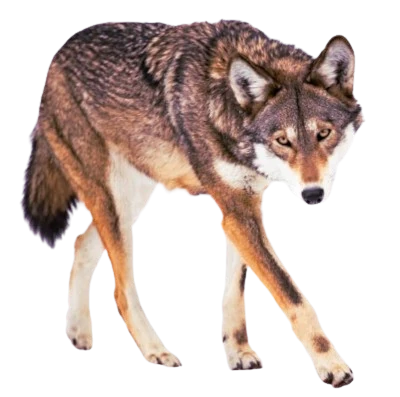
The Red Wolf (Canis rufus) is an endemic wolf species from the eastern United States. Although less known than its cousin the gray wolf, it is equally fascinating. This canid is now critically endangered, but conservation efforts are trying to preserve this unique species.
The Red Wolf is of medium size, measuring about 60 cm at the shoulder and weighing between 20 and 30 kg. Its coat is generally reddish-brown with shades of gray and black, hence its name. It has an agile, slender body adapted for hunting in forests and marshy areas. Its head is smaller than that of the gray wolf, with large ears and bright eyes, often yellow or amber.
The Red Wolf (Canis rufus) belongs to the Canidae family, which includes dogs, foxes, and other canids. Here is the scientific classification of the Red Wolf:
The Red Wolf is more closely related to the coyote and other North American wolf species than to the gray wolf. It evolved independently, developing distinctive traits suited to its specific environment.
The Red Wolf is primarily found in forests, marshy areas, and prairies in the United States, notably in North Carolina and Louisiana. It once occupied a much larger range, but human expansion and habitat loss have reduced its distribution. It prefers remote and undisturbed areas with adequate prey densities for its survival.
The Red Wolf lives in small packs of 2 to 6 individuals. These packs are generally smaller than those of gray wolves, due to the species' low numbers. The social behavior of the Red Wolf is highly organized, with a hierarchy dominated by an alpha pair. It is an excellent communicator, using vocalizations, body signals, and scent marking to coordinate pack activities.
The Red Wolf is an opportunistic carnivore, feeding primarily on small to medium-sized mammals such as rabbits, squirrels, and white-tailed deer. It may also hunt larger prey in groups when necessary. Its diet varies depending on the availability of prey in its habitat.
The Red Wolf is currently critically endangered, with a wild population estimated at fewer than 20 individuals. Its reintroduction in certain protected areas is ongoing, but it remains threatened by hybridization with coyotes, habitat loss, and conflicts with human activities. Captive breeding programs and reintroduction efforts have shown signs of success, but much remains to be done to ensure its long-term survival.
The Red Wolf belongs to the genus Canis, which also includes the Coyote (Canis latrans), the Golden Jackal (Canis aureus), and the Gray Wolf (Canis lupus). These species share common characteristics within the Canid family, notably their complex social structure and pack hunting behaviors.
Observing the Red Wolf in its natural habitat is a rare privilege, given its limited population. If you want to observe this endangered species, here are some tips:
By following these tips, you can help protect the Red Wolf while having an enriching experience.